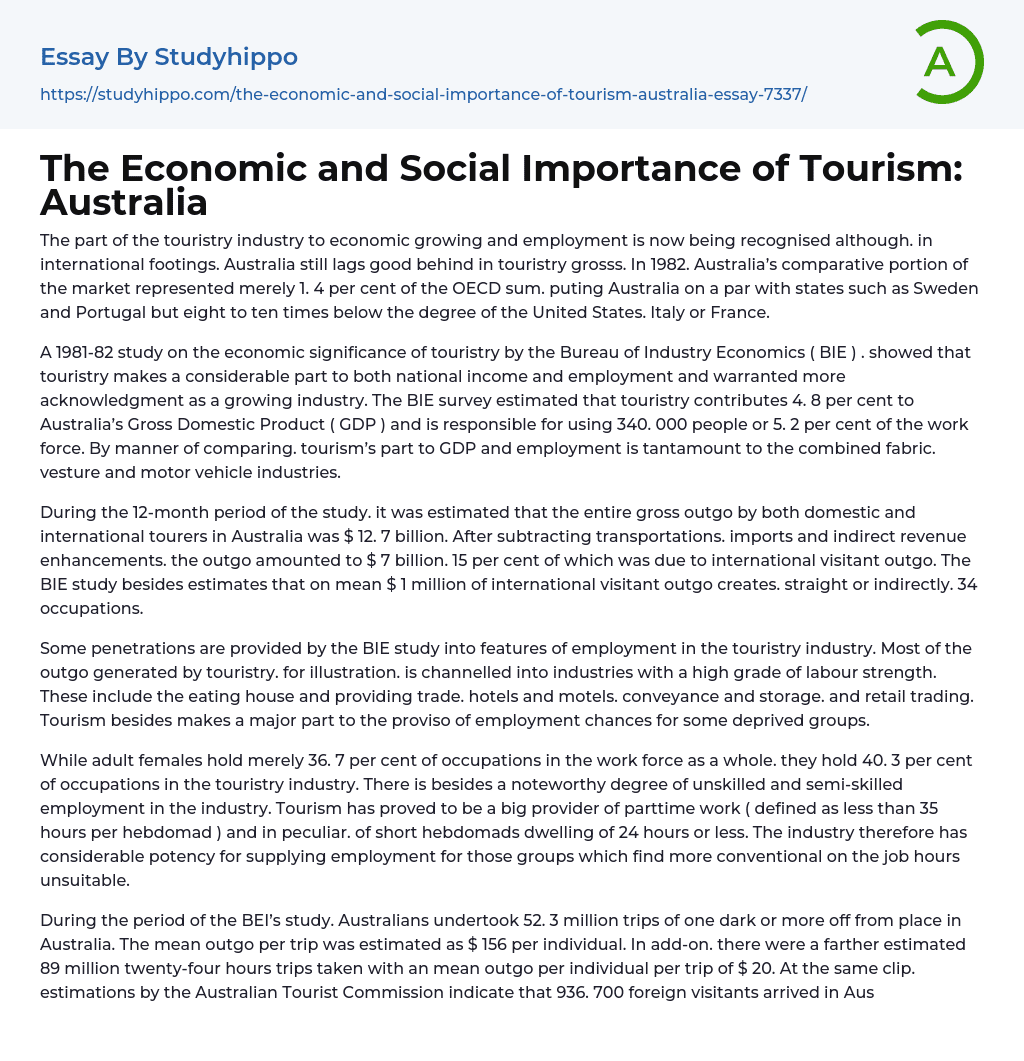

The Economic and Social Importance of Tourism: Australia Essay Example
Although the tourism industry's contribution to economic growth and employment is increasingly recognized globally, Australia falls significantly behind in terms of tourism revenues.
In 1982, Australia's market share in the total OECD was merely 1.4%, similar to Sweden and Portugal but significantly lower than that of the United States by a ratio of eight to ten.
In 1981-82, the Bureau of Industry Economics (BIE) conducted a study that highlighted the positive effects of tourism on Italy and France's national income and employment. The study emphasized the significance of acknowledging tourism as a flourishing industry. According to the survey by BIE, Australia's Gross Domestic Product (GDP) is impacted by tourism with a contribution of 4.8 percent and creating job opportunities for 340 individuals.
During the study period, tourism employed 5.2 percent of the workforce, totaling 000 people. Its contribution to GDP and employment is comparabl
...e to that of the fabric, vesture, and motor vehicle industries combined.
The total gross expenditure in Australia by both domestic and international tourists was estimated at $12.7 billion, considering deductions for transportation, imports, and indirect taxes.
The total expenditure reached $7 billion, with 15% of it coming from international visitors. According to the BIE study, when international visitors spend $1 million, it generates 34 jobs directly or indirectly.
The study conducted by the BIE provides valuable insights into employment within the tourism sector. It highlights that a significant portion of tourism spending directly contributes to industries with a robust workforce.
Within the tourism sector, there are diverse establishments that provide a range of services and opportunities. This includes various industries such as food and beverage establishments (e.g., restaurants and cafes) as well as accommodation options like hotels an
motels. Additionally, transportation and storage services are essential for ensuring the efficient operation of the tourism industry.
In addition to these sectors, retail trading establishments also contribute to fulfilling tourists' needs.
Tourism plays a crucial role in creating job opportunities for disadvantaged groups.
Although adult females represent only 36.7% of the total workforce, they constitute 40.3% of employment specifically in the tourism industry.
The industry offers many job opportunities that do not require extensive skills or training, particularly in tourism. This is beneficial for those looking for part-time work with flexible hours, including individuals who prefer to work less than 35 hours per week or as few as 24 hours per week.
The study conducted by the BEI indicated that Australians made a total of 52.3 million trips within Australia, regardless of their duration. The average expenditure per person for each trip was approximately $156. Furthermore, there were around 89 million day trips taken, with an average spending of $20 per person per trip.
The Australian Tourist Commission reports that Australia received 936,700 international visitors. These visitors spent an average of $1,121 per person per trip and had an average stay of 31 days.
According to a study conducted by the BIE, travel has seen an increase in both domestic and international sectors. In December 1983, there were 54 million domestic trips and 943,900 international visitors.
The number of Australians traveling abroad during this period was 1.25 million, with an average expenditure of $1360 per trip.
Historically, the majority of visitors to Australia have come from its closest neighbor, New Zealand. Currently, visitors from New Zealand account for about 25% of all arrivals. Other significant markets include the United Kingdom and Ireland.
This analysis
includes the United States, Japan, Central Europe, and the Asiatic part. Notable discoveries include a considerable number of departures from Australia and the observation that Australians tend to spend more on trips abroad compared to tours within their own country.
Although the historical balance of payment for tourism has been negative, there are recent indications that the gap between travel credits and debits is decreasing.
- Australian Culture essays
- Cultural Tourism essays
- Afghanistan essays
- Africa essays
- America essays
- Asia essays
- Australia essays
- Caribbean essays
- City essays
- Developing Country essays
- Dubai essays
- Earthquake essays
- Europe essays
- Fracking essays
- Georgia essays
- Middle East essays
- Natural Disaster essays
- New Zealand essays
- North Korea essays
- South Korea essays
- Thailand essays
- Travel essays
- American Dream essays
- Barriers To Entry essays
- Capitalism essays
- Central Bank essays
- Compensation essays
- Consumerism essays
- Economic Development essays
- Economic Growth essays
- Economic Inequality essays
- Economic System essays
- Economy essays
- Employment essays
- Export essays
- Finance essays
- Free Trade essays
- Gross Domestic Product essays
- Human Development essays
- Income Inequality essays
- Industry essays
- Inflation essays
- International Business essays
- International Trade essays
- Macroeconomics essays
- Materialism essays
- Max Weber essays
- Microeconomics essays
- Minimum Wage essays
- Monetary Policy essays



